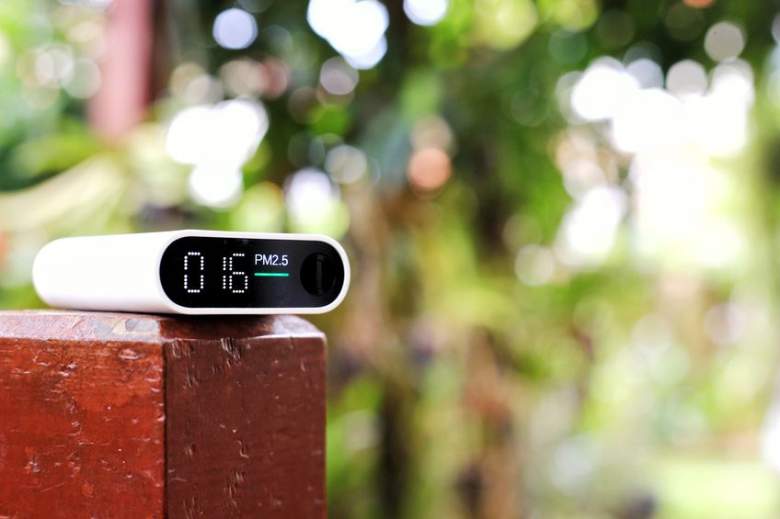
Air contaminants including household dust, dirt, pollen, and mold are common but particles from pollution are becoming common as well due to ever-increasing severe weather events. Smoke from wildfires and dust thrown into the air by storms, hurricanes and tornadoes now impact our daily lives more than ever before.
Understand what’s contaminating the air you breathe with an air quality monitor. These ingenious little devices make it possible to analyze your surroundings and take action before potential health issues take hold of you and your family. Our list of the best indoor air quality monitors will give you a better sense of calm so you can breathe easier.

|
Amazon Customer Reviews
|
Price: $218.97 Shop at Amazon | Shop now Read our review |

|
Amazon Customer Reviews
|
Price: $197.54 Shop at Amazon | Shop now Read our review |

|
Amazon Customer Reviews
|
Price: $229.99 Shop at Amazon | Shop now Read our review |
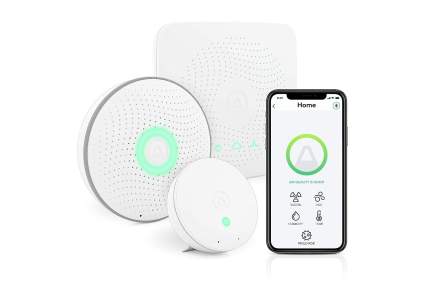
|
Amazon Customer Reviews
|
Price: $299.00 Shop at Amazon | Shop now Read our review |
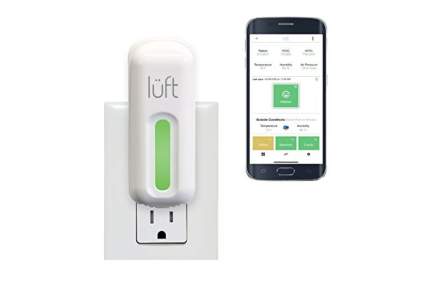
|
Amazon Customer Reviews
|
Price: $249.00 Shop at Amazon | Shop now Read our review |
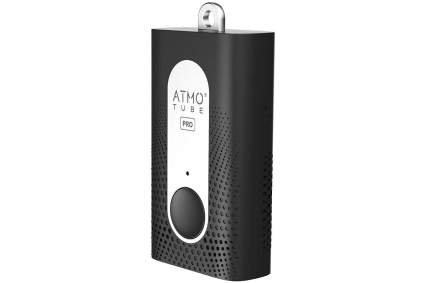
|
Amazon Customer Reviews
|
Price: $179.00 Shop at Amazon | Shop now Read our review |
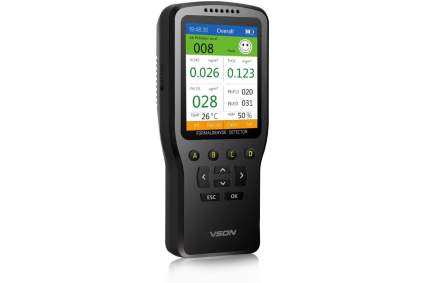
|
Amazon Customer Reviews
|
Price: $98.99 Shop at Amazon | Shop now Read our review |
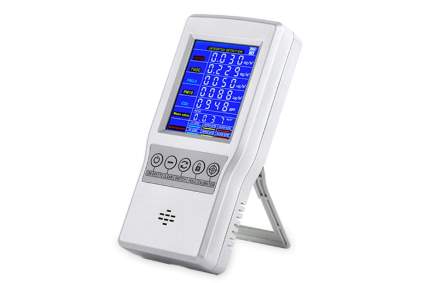
|
Amazon Customer Reviews
|
Price: $75.99 Shop at Amazon | Shop now Read our review |
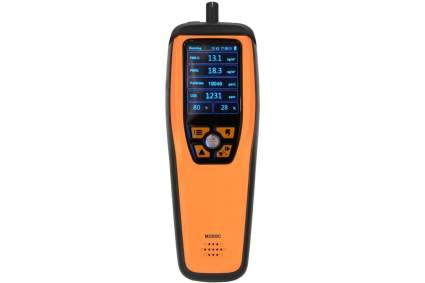
|
Amazon Customer Reviews
|
Price: $139.99 Shop at Amazon | Shop now Read our review |
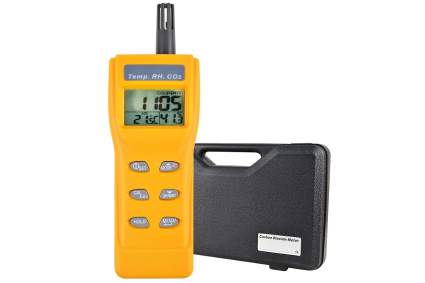
|
Amazon Customer Reviews
|
Price: $134.90 Shop at Amazon | Shop now Read our review |
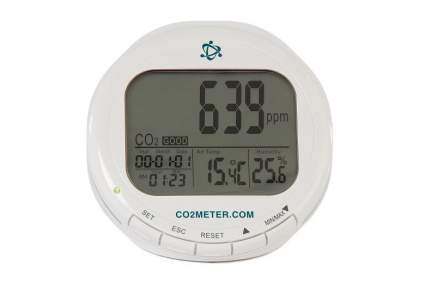
|
Amazon Customer Reviews
|
Price: $79.99 Shop at Amazon | Shop now Read our review |
-
1. Awair Element Indoor Air Quality Monitor
Pros:- Tracks temperature, humidity, CO2, chemicals, and particulate matter
- Gives insight in real-time about your air quality and changes over time
- In-app feedback provides tips about your space
Cons:- Some users reported issues with WiFi connectivity
- Poor tech support
- Doesn't support Nest integration
Everyday activities and household products can seriously affect your ability to breathe and the Awair Element Indoor Air Quality Monitor can help you manage it. This little gadget monitors temperature, humidity, carbon dioxide, chemicals, and particulate matter to give you real-time insight regarding your air quality. The device itself is unobtrusive and will fit in with any decor.
Simply plug it in and let the Element go to work. Its smart assistant integrations (works with Alexa and Google via WiFi) will help to maintain a healthy indoor environment. Working with the Awair app on your mobile device, the Element will monitor your surroundings and give you tips and suggestions as to how to improve your air quality.
Lights on the front of the Element show you what the air quality is at that moment along with a bar graph representation of the various particulates. The combination of the unit and the app to deliver some peace of mind is a great concept.
Find more Awair Element Indoor Air Quality Monitor information and reviews here.
-
2. Huma-i HI-150 Advanced Portable Air Quality Monitor
Pros:- Monitors several types of contaminants
- Built-in fan to draw in ambient air
- Results display in either graph or icon modes
Cons:- CO2 levels presented only in subjective terms, not numerically
- No historical tracking capability
- Low battery life
If you’re looking for an air quality tester that will work anywhere that you do, consider the Huma-i HI-150 Advanced Portable Air Quality Monitor. It measures several types of pollution including particulate matter in PM2.5 and PM10 levels. Its pocket-sized portability is a plus as you can bring it with you anywhere and it will work as well outdoors as it does inside.
The display readout is incredibly simple. Information is available either graphically or numerically with the touch of a button to suit your preference. The emoji type graphic that represents air quality (including one with a mask on) is a nice touch. This monitor features a built-in fan to quickly draw in air that allows for measurements in real-time.
It’s simple, clean, and does the job. The ability to measure quickly for peace of mind is exactly what this little gadget was made for. It doesn’t feature any sort of connectivity, it won’t link up to your phone, and it doesn’t record historical data but that’s not what this monitor was meant for. The Huma-i HI-150 is a good product to slip in your pocket so you can measure air quality whenever and wherever you need to.
Find more Huma-i HI-150 Advanced Portable Air Quality Monitor information and reviews here.
-
3. Airthings Wave Plus
Pros:- Integrates with Alexa, Google Assistant, and IFTTT
- Wave hand in front of device to receive a color-coded quality indicator
- Measures a wide-variety of air contaminants
Cons:- No WiFi connectivity
- Impossible to receive reports on smartphone away from home
- Radon accuracy hits and misses
The Airthings Wave Plus measures six key indoor air factors including radon, CO2, toxins and chemicals, humidity, temperature, and air pressure. The gadget itself looks great and is unobtrusive enough to not be noticed amongst any decor. It communicates via Bluetooth to an app on your mobile device to deliver stats and information.
If you don’t happen to have your phone on you (yeah, right), simply wave your hand in front of the monitor to get a colored ring of light to appear showing you how the air is at the moment. Green means good, red means bad, and so on.
This all in one testing solution is very handy and has received many honors and design awards including from Time Magazine and CES. Online reviews claim that the radon accuracy is average and the lack of WiFI (you’ll need the Airthings Hub for that which is a separate purchase) is frustrating. That said, what the Wave Plus does, it does well.
Find more Airthings Wave Plus information and reviews here.
-
4. Airthings 4200 House Kit
Pros:- Compatible with Alexa, Google Assistant and IFTTT
- Historical stats tracking feature
- Convenient all-in-one package
Cons:- Kit doesn't measure CO2 levels
- Reports of issues working with Google Assistant
- Multiple devices required to test various contaminants in home
The Airthings 4200 House Kit includes two air quality monitoring devices and a hub that connects everything. The two devices are the Wave (2nd Generation) and the Wave Mini which between them will give you statistics on radon, mold risk, total VOCs (toxins and chemicals), humidity, and temperature. Each product in the kit is available individually, outside this kit, as well.
Basically, it comes down to this: the Wave is a radon gas-measuring device and the Mini measures mold contaminants along with VOCs. Both of the monitors together give you a wide range of information but neither of them measures CO2 levels. The Wave Plus is the best of the bunch but it doesn’t feature WiFi connectivity and online reviews claim that its radon reporting isn’t that accurate.
The Hub is pretty much just that: a gadget to connect the various Airthings products in the home together to deliver that information via WiFi to your smartphone. It also is available as a separate purchase outside this kit.
The most popular feature of this line is the ability to wave your hand (hence the name) in front of it to be presented with a color-coded indicator of what the air quality level is at that moment. That’s pretty cool.
These gadgets look great and work admirably here and there but to get readings of what all is in the air of your home takes numerous devices to do it. It would be really nice if Airthings would come out with one singular product that tested multiple contaminants and offered WiFi connectivity.
Find more Airthings 4200 House Kit information and reviews here.
-
5. lüft Plug-In Indoor Air Quality Monitor
Pros:- Plugs into any 110V wall receptacle
- Accessible from anywhere via mobile app
- Simple color-coded threat indicator
Cons:- No data screen
- No obvious way to calibrate
- Expensive
Featuring sensors for six different points of data and both WiFi and Bluetooth connectivity, the lüft Indoor Air Quality Monitor is sort of like an Apple device: it simply works right out of the box. Just plug the unit into any 110V household outlet and download the app on your smartphone. There are no mounting plates or extra screws to mess with.
The LED light on the face of the air quality monitor is color-coded to show you wordlessly what the conditions are in your home. Green is good, yellow is caution, and so on. When connected to WiFi, your lüft will communicate with you anywhere you are via your mobile device. You can set your own notification levels via the app so that you receive warnings if air quality passes a negative threshold.
The lüft measures radon, CO2, toxic chemicals, temperature, humidity, and barometric pressure. The app is easy to use and disseminate information from as well. Literally, anyone can use this gadget with a definite level of sophistication. It’s a little more expensive than other air quality monitors however its convenient ease of use might be worth it.
Find more lüft Plug-In Indoor Air Quality Monitor information and reviews here.
-
6. Atmotube Pro Portable Outdoor and Indoor Air Quality Monitor
Pros:- Measures contaminants and weather statistics
- Historical tracking capability
- Will send an alert if air quality gets below a certain point
Cons:- Doesn't monitor CO2 levels
- You're paying for the portability
- Bluetooth connectivity can be intermittent
Find more Atmotube Pro Portable Outdoor and Indoor Air Quality Monitor information and reviews here.
-
7. VSON Air Quality Pollution Monitor
Pros:- Measures seven data types including three particulate sizes
- Advanced fan and five sensors
- Portable and rechargeable
Cons:- Only measures temperature in Celsius
- Manual is small and difficult to read
- Average battery life
The VSON Air Quality Pollution Monitor is a portable machine that fits easily in a pocket while providing easy to read information on its full-color LCD screen. Five unique sensors record and display data including reading on formaldehyde, benzene, particulate matter, temperature, and humidity. The numerical information is good for scientific tracking but this tester also features an easy to understand emoji as well.
The average levels of each gas and contaminants are displayed prominently in real-time. A color and sound alarm feature is included that will go off when air quality levels are bad enough to warrant. This air quality monitor has a built-in 1000mAh rechargeable battery with a USB cable. Battery life is average at around three to five hours of use.
This device is portable enough to get packed in a bag or coat pocket to go traveling, camping, and anywhere else you want to measure the air quality. The VSON Air Quality Pollution Monitor is a great solution to get immediate answers to what you’re breathing at any given moment.
Find more VSON Air Quality Pollution Monitor information and reviews here.
-
8. Biaoling Air Quality Monitor
Pros:- Typical eight hour runtime before needing to be charged
- Easy-to-read information
- Short wait time between sampling and confirmation; less than five minutes
Cons:- Does not measure exterior air quality index (AQI)
- Readings are different when charging than when it isn't
- Not meant to be scientifically accurate; more of a ballpark air quality estimate
This popular device, the Biaoling Air Quality Monitor, features easy to read particulate numbers on a bright LCD color screen. It measures various contaminants including CO2, HCHO, TVOC, PM2.5, and PM10, all at the same time. This air quality tester features electrochemical sensors that provide accurate measurements that should report slight fluctuations in air quality.
All the particulate data is displayed at the same time in realtime for up to the minute understanding of the air you’re breathing. Simply turn it on, wait between one and five minutes and the sensors will provide the data on the screen for you to take in. The large 3,000mAh battery fully charges in around four hours and lasts between eight and twelve depending on use.
If you’re looking for a premium device that can interface with your home gadgets and provide data comparison from the cloud, this isn’t it. However, if you’re looking for a ballpark estimate on the types of pollutants in your home or office, this will go a long way in letting you know what you’re breathing in.
Find more Biaoling Air Quality Monitor information and reviews here.
-
9. Temtop M2000C Air Quality Monitor
Pros:- Laser particle sensor
- Built-in rechargeable large capacity battery
- Nice control panel layout
Cons:- Temperature and humidity readings take longer than normal to adjust
- Alarm must be set for one type of particulate, not several
- No connectivity features to mobile device or the Internet
This M2000C Air Quality Monitor from Temtop features a particle laser sensor, a humidity and temperature sensor, an infrared CO2 sensor, and digital signal amplification to relay more accurate data. It’s a simple air quality tester that provides monitoring data for PM2.5 and PM10 particulates, CO2, temperature, and humidity. Portable with a 2,200mAh rechargeable battery, this little gadget can go everywhere you go and will give accurate readings both indoors and out.
The color screen is bold and bright with clear numbers and text for easy reading. Controls are laid out under the screen in a wheel pattern with simple iconography. An audio alarm feature is nice but may only be set to one type of contaminant.
Temtop offers another tester, the M2000, that does everything the M2000C can handle but also keeps track of formaldehyde (HCHO) as well.
Find more Temtop M2000C Air Quality Monitor information and reviews here.
-
10. Gain Express Digital Indoor Air Quality Monitor
Pros:- Lightweight and easy to hold
- Accurate CO2 sensitivity
- If you only need to measure CO2, this is the device to have
Cons:- Lots of button mashing to get through functions
- Unit is fragile; don't drop it
- It's not going to win any design competitions
If you’re looking to monitor CO2 levels, and only CO2 levels, this Digital Carbon Dioxide Monitor from Gain Express is the one to have. This device measures CO2, temperature, humidity, and dew point. That enormous 1980s walkie-talkie antenna looking thing sticking up from the top is the NDIR sensor.
No, it really doesn’t care that you think it looks like a contractor-grade piece of tech from 40 years ago. It measures CO2 and it measures it seriously well. What it doesn’t do seriously well is operate in a simple manner. This is a tool for scientists and sub-contractors and not for the average homeowner. That said, once you get the hang of what the buttons do and how they operate, this is a really nice CO2 monitor to have around.
This air quality tester comes with the ability to calibrate CO2 and humidity readings, a hard carrying case, and the ability to connect to your PC for online data analysis. It updates readings each second on the backlit LCD screen and will sound a warning alarm when a certain toxicity level is reached.
Find more Gain Express Digital Indoor Air Quality Monitor information and reviews here.
-
11. CO2Meter AZ-0004 Indoor Air Quality Monitor
Pros:- Will effectively identify CO2 contamination in your home
- Saves settings when disconnected from power
- Alarm feature to alert when readings approach toxic levels
Cons:- Readings are limited to temperature, CO2, humidity
- No historical tracking function
- No smart device integration capability
The CO2Meter AZ-0004 Indoor Air Quality Monitor allows you to quickly, accurately, and (most importantly?) inexpensively test CO2 levels around your home. Move from room to room to test contaminant levels. It will reveal if your home’s climate control systems are operating properly.
High CO2 levels may indicate inadequate or closed return air ducts. On the other hand, low CO2 levels may mean too much fresh air and wasted heating or cooling energy. In addition to the carbon dioxide meter, this monitor has an accurate digital thermometer and relative humidity indicator.
Use it to test your child’s bedrooms; did you know low humidity in the winter can lead to nosebleeds, coughs, and sore throats? High humidity means mold has the opportunity to move in and create structural damage. This little device has an alarm feature that will warn you when levels are approaching toxic levels so you can take action.
Find more CO2Meter AZ-0004 Indoor Air Quality Monitor information and reviews here.
What Does an Air Quality Monitor Do?
With wildfires and other severe weather events becoming an annual occurrence, the quality of the air we all breathe is taking a beating. Luckily there are services online such as Airnow.gov. Thanks to the Internet, you can instantly find out what the outside air quality is in your community.
But what about day-to-day life at home? Air quality monitors use internal sensors to analyze the surrounding air then report on its chemical composition. Modern air quality monitors work extremely quickly, usually less than a minute, to provide crucial information so you can make decisions on how to improve the air if necessary.
The most common contaminants that testers may pick up include Carbon Dioxide (CO2), Formaldehyde (HCHO), and Volatile Organic Compounds (TVOC). Particulate matter may also be detected and are carry labels of PM2.5 and PM10; this means particulates 2.5 micrometers or less in diameter and 10 micrometers or less in diameter, respectfully. PM2.5 matter is generally described as "fine" particles. To understand this better, a human hair is around 100 micrometers in width.
As concerns grow over global warming, more and more organizations around the world recommend the use of air quality monitors in both industrial and residential locations. Technology now makes it possible for air quality monitors to access meteorological data via the Internet as well to use that data when interfacing with other home gadgets such as a thermostat.
These little boxes make it possible for anyone to devise an action plan to improve the performance of building systems and public spaces. Being aware of just what's in the air around you is an excellent step to increase thoughtfulness and understanding about the environment.
What Should I Look For in an Air Quality Monitor?
Now that the Internet can be accessed in just about anyone's home, it's a good idea if the air quality monitor you're looking at has the ability to integrate with your other smart home devices. Some air quality testers can be controlled using Alexa or Google Assistant.
This means that most monitors on the market today can be accessed with a computer, tablet, or mobile device. Check your readings at home or on the road. A backlit LED display is a nice feature so you can check the readings on the unit itself in case your mobile isn't handy.
Picking up an air quality monitor that has a history feature is advisable. Checking on whether quality has gotten better or worse over time is pretty much why you got the gadget in the first place! Being able to adapt your air improvement plans using historical readings is a must.
Can Air Quality Monitors Detect Mold?
The short answer is yes, air quality testers can absolutely check for different types of mold in your home or office. But how they do it is more complicated.
Various particulates such as dust, cleaning chemicals, high levels of humidity, and building materials may all be tracked using an air quality monitor. Some may even track the contamination levels of outdoor air as well to provide a baseline for what's going on inside.
Mold is a definitive contamination that can be tracked by your new home gadget. Hiding away in warmer areas of your house, it can become airborne which means you can inhale it which means *COUGH COUGH COUGH*
Air quality monitors with particle detectors are what you want to look for. Because mold spores take up space within the air, the sensing equipment inside the monitor will record those spores as similar particulate matter and your resulting overall count will be higher.
Unfortunately, air quality testers aren't omnipotent and really have no way of telling you (not yet at least) what type of mold might be floating around your home. By comparing your counts with average readings via the Internet and taking on a little detective work, you can detect a mold problem and figure out what to do about it.
See Also: